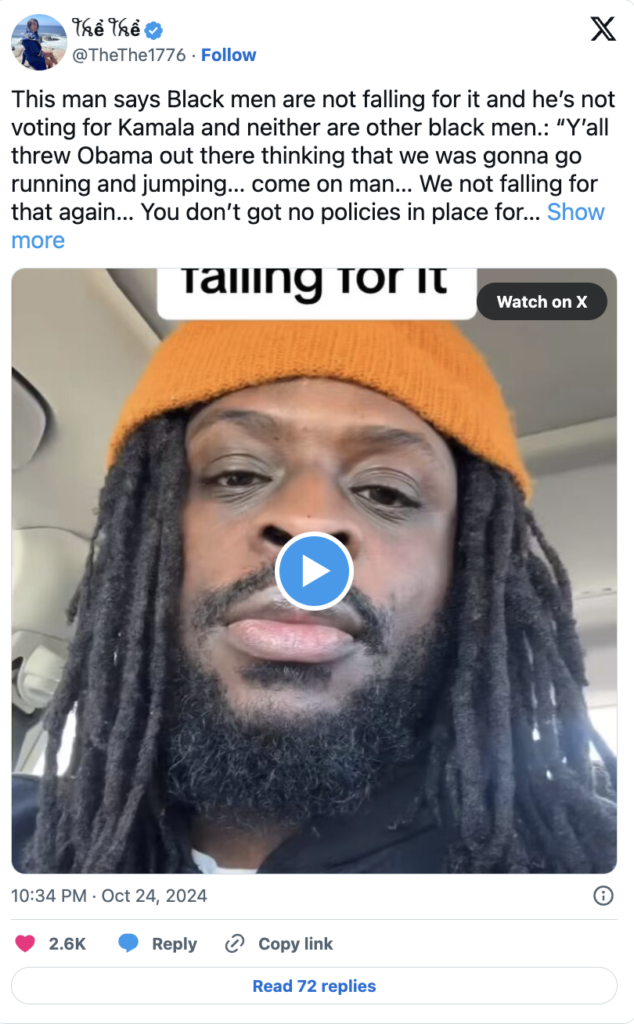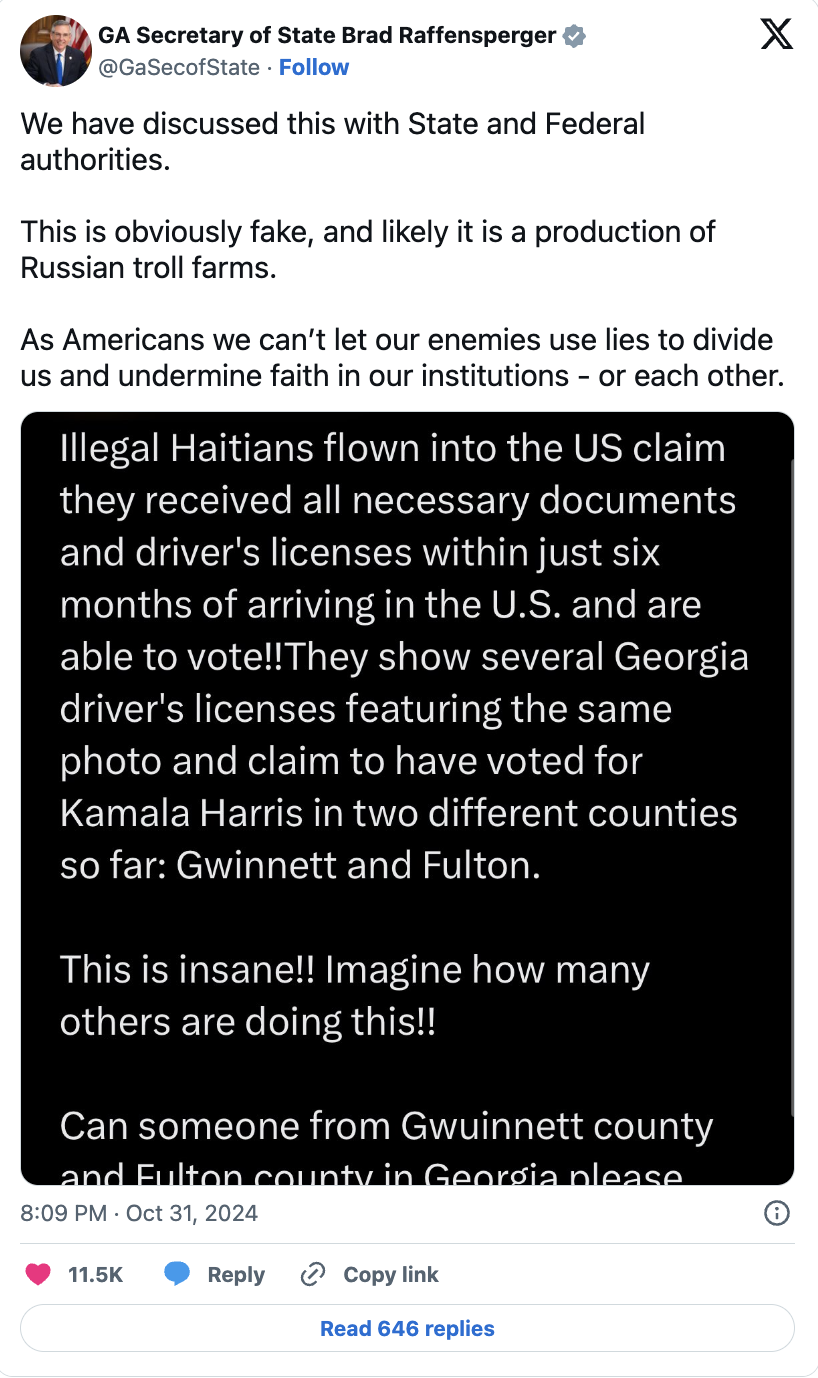(Route Fifty) —
Dominique Grate, a college-educated executive at an HBCU in the politically pivotal state of Texas, was scrolling through his Facebook feed just ahead of Election Day when an ad popped up featuring an image of Donald Trump, American flags, and a tagline falsely suggesting that Trump, as president, sent stimulus money as a “gift” to Black communities.
Grate, 34, said he recognized the post as misleading almost immediately. Annoyed, he quickly scrolled past so that it didn’t disrupt his algorithm and send more ads like that his way.
“When people are trying to win your vote, it’s not surprising that in a state with a competitive battleground senate race, and 40 Electoral College votes, they’re willing to say anything,” Grate said.
While the former president did technically sign pandemic relief checks, it was largely pushed through by the Democratic majority in the House of Representatives, in March and December 2020. Vice President Kamala Harris includes that fact check in her presidential campaign and former NFL star Shannon Sharpe, explained on the popular podcast, Club Shay Shay, “There was a whole lot of opposition to it including from Donald Trump’s White House … Congress wrote those checks.”
The post likely wound up in Grate’s social media feed because he is a millennial, Black man, in Texas — a state with competitive congressional races and 40 Electoral College votes.
It’s the type of targeted disinformation that Esosa Osa, CEO and founder of Onyx Impact, a nonprofit organization that works to combat misinformation aimed at Black communities, says is growing rapidly and aims to “distract, deter, and deny” voters of color from engaging in the electoral process.
In a modern era, voter suppression looks like this: harmful social media posts that use technology to target communities of color in swing states, psychological ops employed to create disillusionment and apathy, and viral posts aimed at misdirecting would-be voters. The purpose: dilute the strength of communities of color as voting blocs to help ensure that control of political and policy power structures remain with and benefits those who identify as part of the majority.
Evolving social media policies have complicated efforts to prevent voter suppression. From Instagram to TikTok, a mix of bots, influencers, and even foreign actors generate used viral posts to spread misinformation and manipulate political perceptions and dissuade voters, particularly those from communities of color from casting ballots for their preferred candidates or even voting at all.
“Disinformation has long been wielded by those in power — or those seeking authoritarian control,” said Nora Benavidez, who, as senior counsel and director of Digital Justice and Civil Rights for Free Press, leads the media outlet’s democracy and tech initiatives.
“As progress is made, those forces that do not want equity, progress, and innovation for all seek to undo it,” she continued. “Our communities are being torn apart by lies, conspiracy, and hate. What’s at risk now is ourselves.”
Digital voter suppression has evolved far beyond fake polling hours or false election dates, according to Angie Drobnic Holan, director of the International Fact-Checking Network. Holan explains that it now extends into psychological tactics aimed at discouraging participation.
“When people are told the election is rigged, that nothing matters, or that their vote doesn’t count, it’s impossible to believe this doesn’t discourage people from voting,” Holan said. “Voter apathy is a big issue, and this perpetuates it.”
The impact can particularly be seen in swing states such as Arizona, Georgia, Michigan, Nevada, North Carolina, Pennsylvania and Wisconsin, where there are significant populations of Black and/or Latino voters and are targets for ramped up misinformation and disinformation schemes during election years. For example, federal authorities recently intercepted a plot by Russian actors claiming that some American election officials were plotting widespread voter fraud in swing states.
According to 404 Media, the Elon Musk-funded Future Coalition PAC is running targeted ads with opposing messages about the vice president. In Muslim communities in Michigan, the ads portray Harris as pro-Israel and influenced by her husband, Doug Emhoff, who is Jewish. Meanwhile, in Jewish communities in Pennsylvania, the ads accuse Harris of being antisemitic and of opposing military support for Israel against Hamas.
“Targeting Latinos in Texas and Arizona, and Indigenous people in the plain states, are things that help consolidate the power of the Republican Party,” said Alvin Tillery, a professor of political science and the director of the Center for the Study of Diversity and Democracy at Northwestern University. “Which is essentially a party of White men, at this point — and that’s who benefits.”
Just this week, X user @MAGAResource shared a deepfake — or deceptive, digitally altered image — of Martin Luther King Jr. In the video, which has been viewed more than 13 million times to date, King appears to be talking about how disappointed Black voters are with the Democratic Party.
“This is a form of voter suppression and it’s as old as White supremacy,” said Osa, who founded the company last October to address the spread of misleading and harmful information targeting Black communities through educational campaigns and impact reports.
“The difference now is that the tools have become more sophisticated and widely accessible.”
The digital tools of voter disenfranchisement
Osa categorizes “the information disorder spectrum” into three main types: misinformation, disinformation, and malinformation.
“Misinformation is incorrect information that’s shared,” she explained, citing examples like inaccurate polling hours.
Disinformation, by contrast, is “false information pushed with intent to deceive.” Malinformation involves true information shared with the intent to harm, such as doxing or publishing someone’s personal details online.
“In each case, the goal is the same: keep people from the polls,” Osa emphasized.
Foreign actors are adding fuel to these efforts. Recently, Georgia Secretary of State Brad Raffensperger warned that a viral video, allegedly depicting Haitian immigrants casting multiple ballots, was in fact AI-generated footage produced by the Russian government.
“There are domestic and foreign actors right now spreading disinformation into Black spaces,” Osa said.
Earlier this year, Onyx Impact released a report that revealed disinformation campaigns targeting Black communities could be reaching at least 40 million Americans across social media platforms.
And in an era of increased mainstream media distrust, these campaigns exploit the trust audiences place in popular media like podcasts and YouTube channels, where harmful messages can quickly reach and influence millions.
“If you can get one of these narratives talked about on what we call gateway platforms or influencers, it’s far more likely that this information can go viral,” Osa explained.
For example, a video posted on X by a man claiming to represent Black men tells Vice President Kamala Harris that they won’t vote for her, citing several reasons, including the false claim that Harris didn’t identify as Black until her presidential campaign. In this one post, the video has been viewed over 27,000 times and has shown up on various social media platforms.
In Florida and Arizona, Latino voters face misleading messages on immigration and socialism, with claims that certain Democratic candidates support undocumented immigrants voting or have ties to socialism, stoking fear, especially among Cuban and Venezuelan communities who are historically vulnerable to this rhetoric.
For example, an AI-generated meme that shows Vice President Kamala Harris in a Communist leader’s uniform — alongside Minnesota Gov. Tim Walz in front of a fake “Revolutionary Communists of America” banner — has circulated widely on X.
Throughout the campaign season, multiple fact-checking organizations have flagged trends in misinformation and false claims of noncitizens voting en masse.
“The lie that we are seeing that troubles me is this false claim that noncitizens are engaging in mass voter fraud, that they’re being bused into locations to vote illegitimately, that they’re, you know, somehow finding ways to take people’s identities,” Benavidez said.
“It creates villains for everyday people in communities where they’re really just trying to get by.”
As a result, in some cases, voters who are legally able to do so are either scared to go vote out of fear of retribution or have their right to cast ballots unfairly challenged.
New psychological tactics in voter suppression
This post on X discourages voter participation with a meme that suggests “the hood” (low socioeconomic areas) remains the same regardless of who is president.

Leveraging the collective power of informed voters of color
Both Osa and Holan agree that social media platforms play a role in enabling these online tactics and urge voters to protect themselves by carefully choosing information sources. Osa advises selecting two or three trusted news sources.
“It’s important to confirm with two sources before you share stories,” she said. “Now, more than ever, voters need access to accurate and truthful information.”
Onyx Impact is actively working to provide Black communities with reliable information by partnering with trusted media outlets. Holan underscores that voter participation is crucial. “We can’t have a democracy if people don’t vote,” she stated.
Both experts warn that digital disinformation will continue to grow more insidious unless the public, policymakers, and tech companies address it head-on. “The misinformation aimed at suppressing the vote should be of concern to all of us,” Holan stressed.
“This is fundamentally about the collective power of voters of color,” Osa added. “When we’re fully informed, we use our power to shape the future of our communities.”
—
Read More News from Route Fifty

